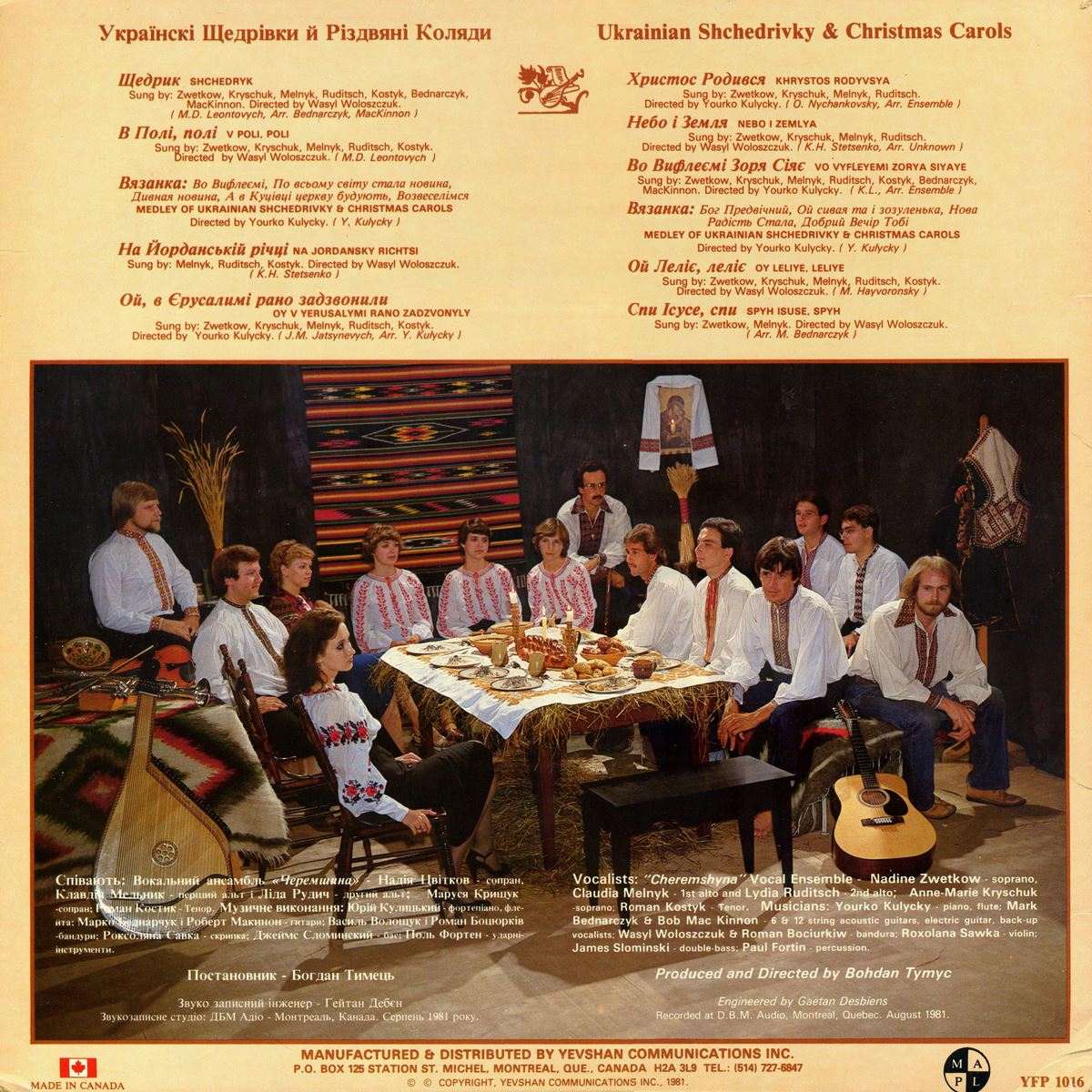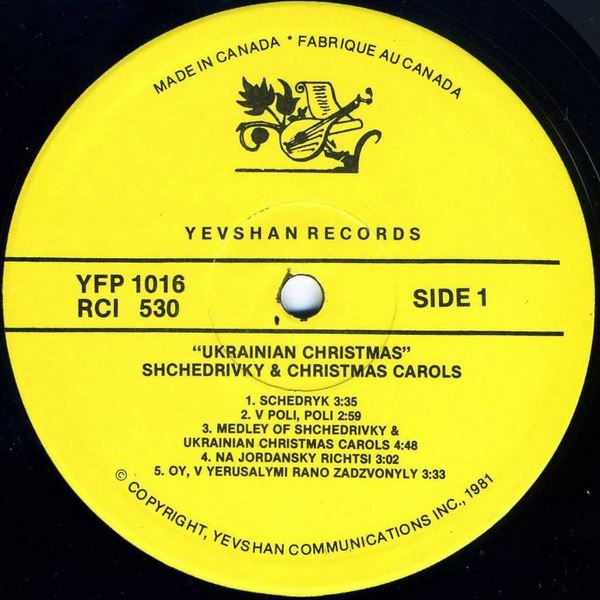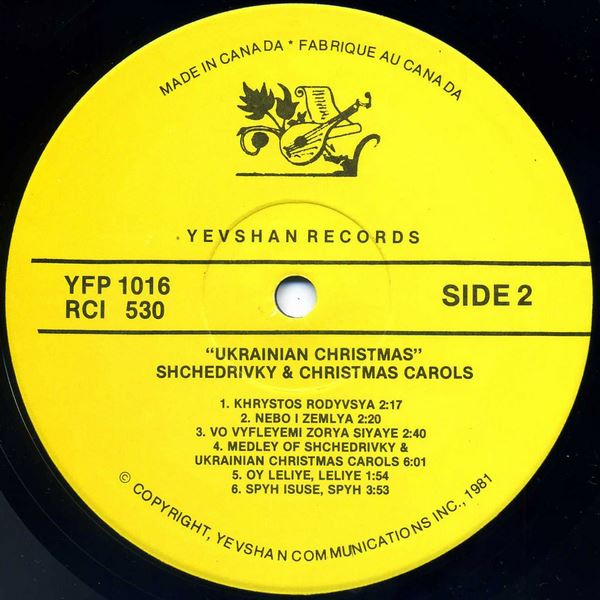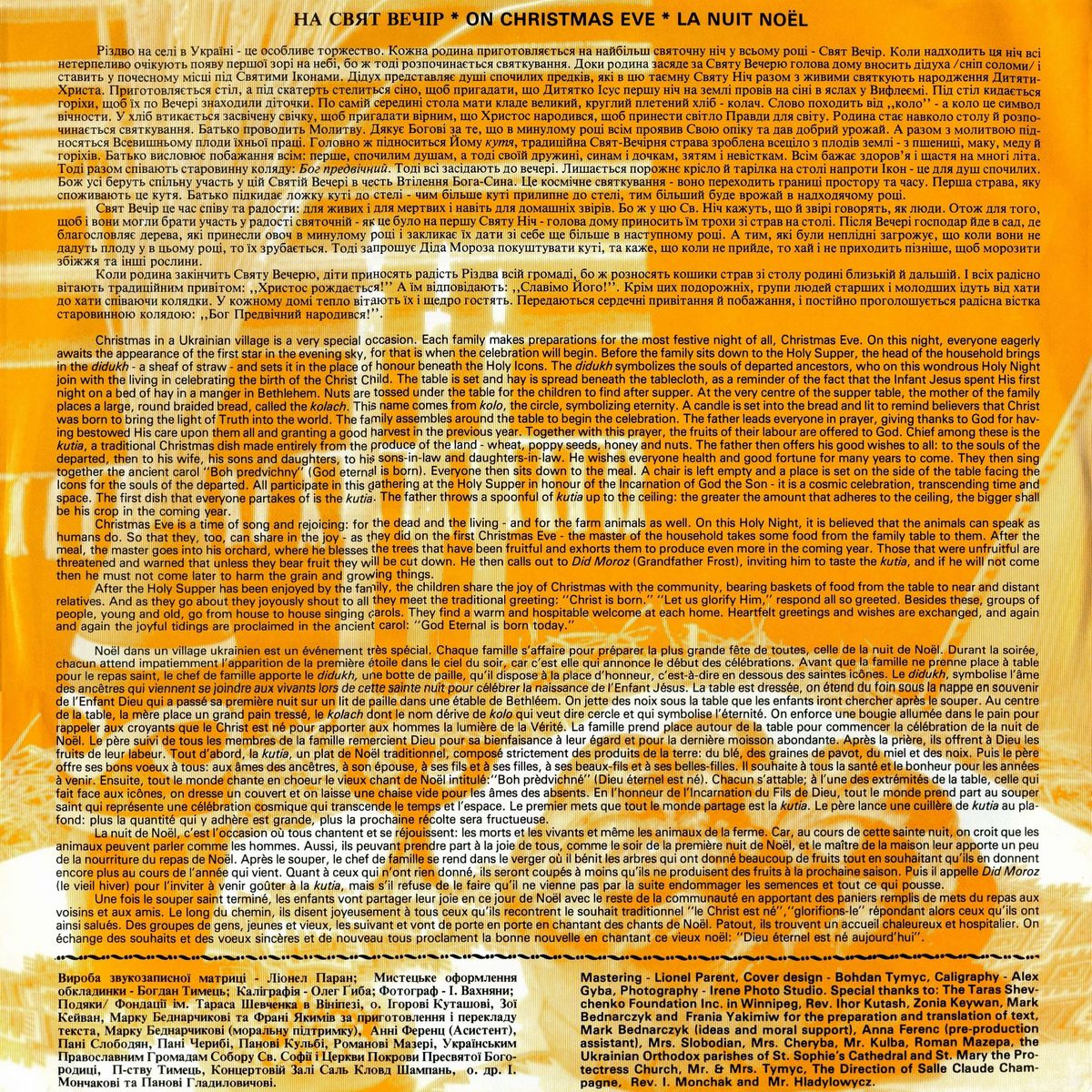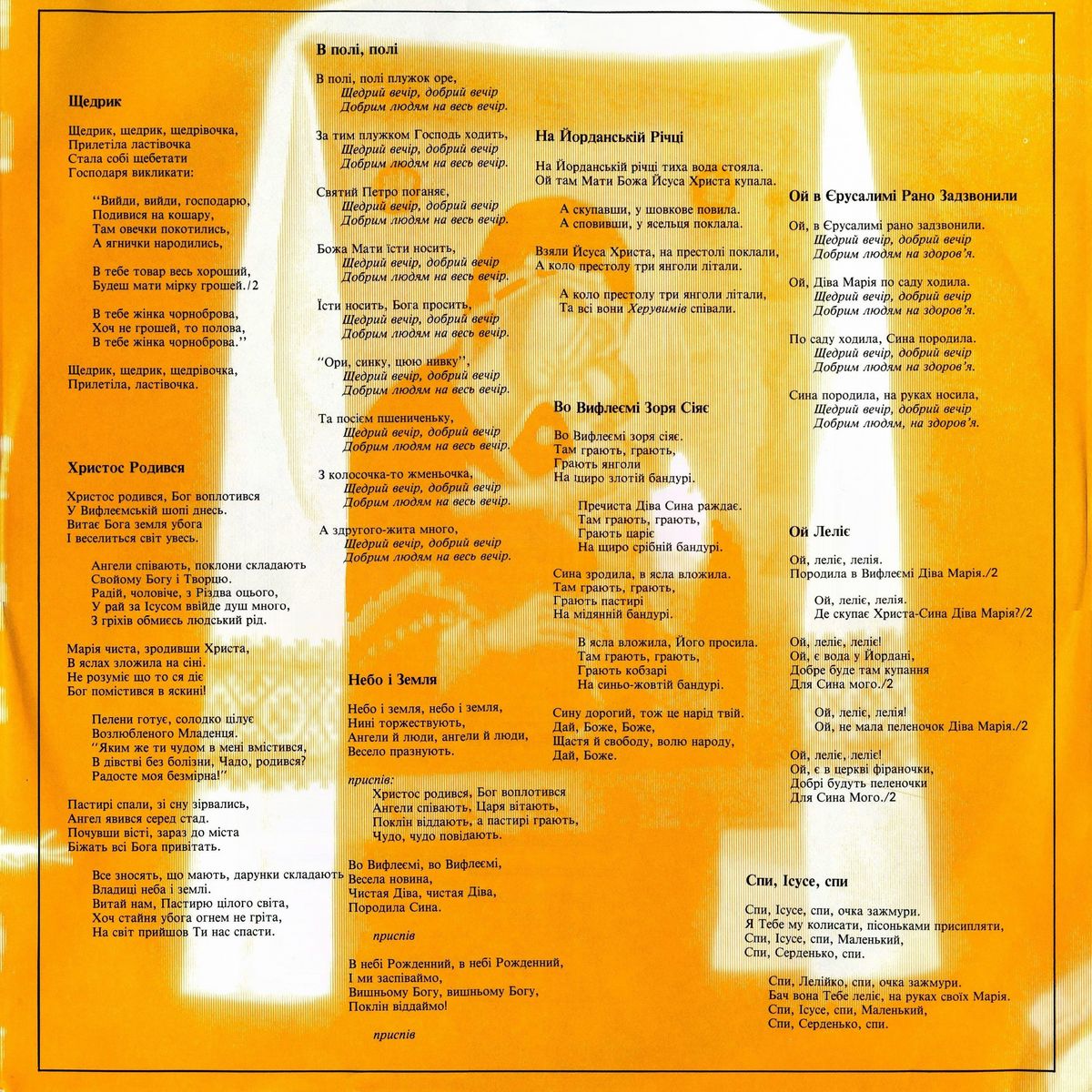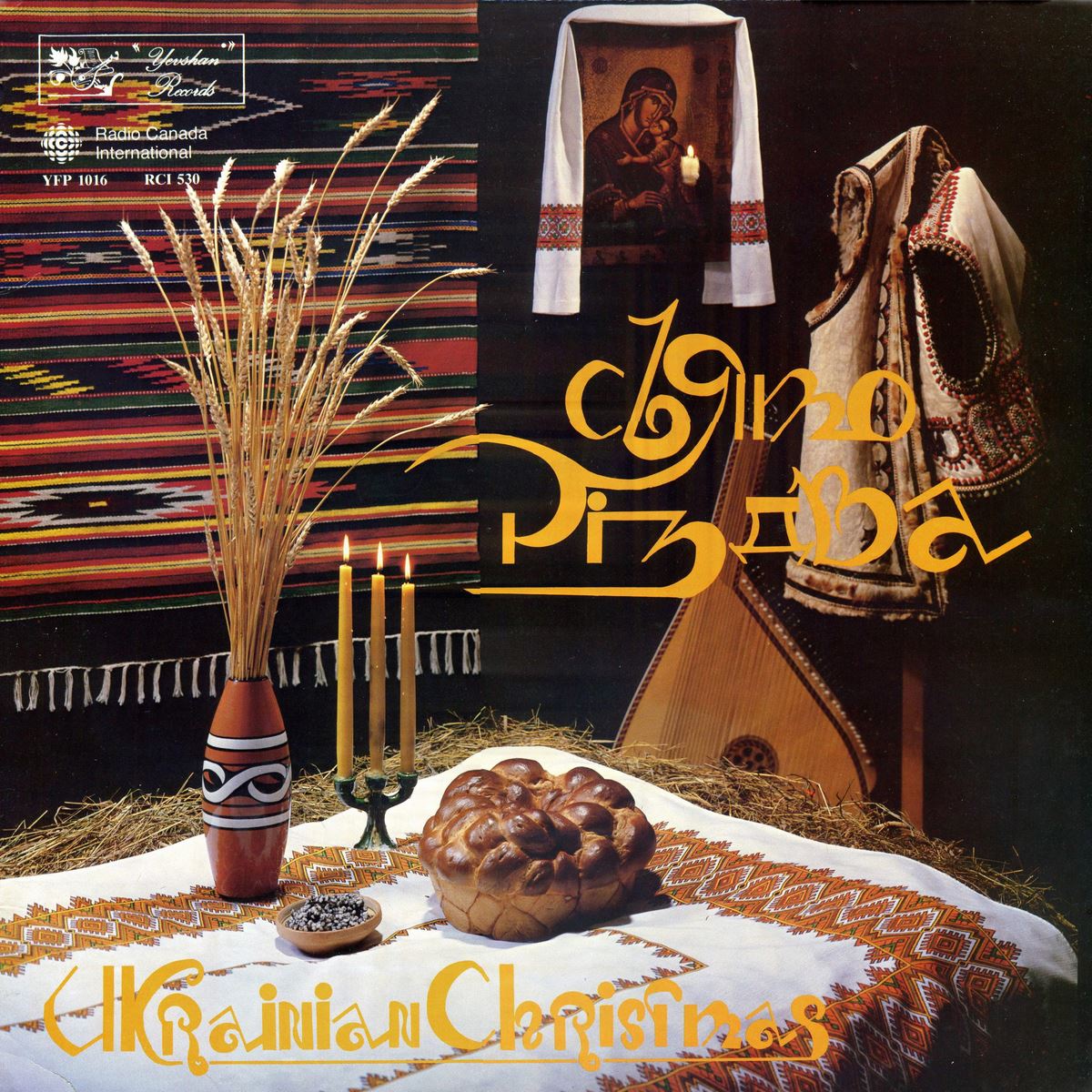
Ансамбль Черемшина – Свято Різдва
Виконавець: Вокальний ансамбль «Черемшина» / Vocal ensemble «Cheremshyna»
Альбом: Свято Різдва / Ukrainian Christmas
Видавець: Yevshan Records – YFP 1016
Формат: Vinyl, 12″, 33 ⅓ RPM
Дата видання: 1981
Джерело: колекція та оцифрування Andriy Vasylyk
| Сторона 1 | |
| 01 | Щедрик (Schedryk) – Sung by: Zwetkow, Kryschuk, Meinyk, Ruditsch, Kostyk, Bednarczyk, MacKinnon. Directed by W. Woloszczuk. (M.D. Leontovych, An. Bednarczyk, MacKinnon) |
| 02 | В полі, полі (V poli, poli) – Sung by: Zwetkow, Kryschuk, Meinyk, Ruditsch, Kostyk. Directed by W. Woloszczuk. (M.D. Leontovych ) |
| 03 | В’язанка: Во Вифлиємі, По всьому світу стала новина, Дивная новина, А в Києві церкву будують, Возвеселімся Medley of ukrainian shchedrivky & christmas carols – Directed by Y. Kulycky |
| 04 | На Йорданській річці (Na Jordansky richtsi) – Sung by: Meinyk, Ruditsch, Kostyk. Directed by W.Woloszczuk. (K.H. Stetsenko) |
| 05 | Ой, в Єрусалимі рано задзвонили (Oy v Yerusalymi rano zadzvonyly) – Sung by: Zwetkow, Kryschuk, Meinyk, Ruditsch, Kostyk. Directed by Y.Kulycky. (J.M. Jatsynevych, An. Y. Kulycky) |
| Сторона 2 | |
| 06 | Христос родився (Khrystos rodyvsya) – Sung by: Zwetkow, Kryschuk, Meinyk, Ruditsch. Directed by Y.Kulycky. (0.Nychankovsky, Arr. Ensemble) |
| 07 | Небо і земля (Nebo i zemlya) – Sung by: Zwetkow, Kryschuk, Meinyk, Ruditsch. Directed by Wasyl Woloszczuk. (K.H. Stetsenko, Arr. Unknown |
| 08 | Во Вифлеємі зоря сіяє (Vo Vyfleyemi zorya siyaye) – Sung by: Zwetkow, Kryschuk, Meinyk, Ruditsch, Kostyk, Bednarczyk, MacKinnon. Directed by Yourko Kulycky. (K.L., Arr. Ensemble) |
| 09 | В’язанка: Бог предвічний, Ой сива та і зозуленька, Нова радість стала, Добрий вечір тобі – Medley of ukrainian shchedrivky & christmas carols Directed by Y. Kulycky |
| 10 | Ой Леліє, леліє (Oy Leliye, Leliye) – Sung by: Zwetkow, Kryschuk, Meinyk, Ruditsch, Kostyk. Directed by Wasyl Woloszczuk. (M.Hayvoronsky) |
| 11 | Спи Ісусе, спи (Spy Isyse, spy) – Sung by: Zwetkow, Meinyk. Directed by Wasyl Woloszczuk. (Arr. M.Bednarczyk ) |
Вокальний ансамбль “Черемшина”:
– Надія Цвітков – сопран
– Клавдія Мельник – перший альт
– Ліда Рудич – друши альт
– Маруся Крищук – сопран
– Роман Костик – тенор
Музичне виконання:
– Юрій Кулицький – фортепіано, флейта
– Марко Беднарчук і Роберт Макинон – гитари
– Василь Волощук і Роман Боцюрків -бандури
– Роксолана Савка – скрипка
– Джеймс Сломинский – бас
– Поль Фортен – ударні інструменти.
– Богдан Тимець – постановник
Звуко записний інженер – Ґейтан Дебєн
Звукозаписне студіо: ДБМ Адіо – Монтреаль, Канада. Серпень 1981 року.
Vocalists: “Cheremshyna” Vocal Ensemble – Nadine Zwetkow – soprano, Claudia Melnyk – 1st alto and Lydia Ruditsch – 2nd alto; Anne-Marie Kryschuk – soprano; Roman Kostyk – tenor. Musicians: Yourko Kulycky piano, flute; Mark Bednarczyk & Bob Mac Kinnon – 6 & 12 string acoustic guitars, electric guitar, back-up vocalists; Wasyl Woloszczuk & Roman Bociurkiw – bandura; Roxolana Sawka – violin; James Slominski double-bass; Paul Fortin – percussion.
Produced and Directed by Bohdan Tymyc
Engineered by Gaetan Desbiens Recorded at D.B.M. Audio, Montreal, Quebec. August 1981.
Вироба звукозаписної матриці – Ліонел Паран; Мистецьке оформлення обкладинки – Богдан Тимець; Каліграфія – Олег Гиба; Фотограф – І. Вахняни; Подяки: Фондації ім. Тараса Шевченка в Вініпезі, о. Ігорові Куташові, Зої Кейван, Марку Беднарчикові та Франі Якимів за приготовлення і перекладу текста, Марку Беднарчикові (моральну підтримку), Анні Ференц (Асистент), Пані Слободян, Пані Черибі, Панові Кульбі, Романові Мазері, Українським Православним Громадам Собору Св. Софії і Церкви Покрови Пресвятої Богородиці, П-ству Тимець, Концертовій Залі Саль Кловд Шампань, о. др. І. Мончакові та Панові Гладиловичові.
Mastering – Lionel Parent, Cover design – Bohdan Tymyc, Caligraphy – Alex Gyba, Photography – Irene Photo Studio. Special thanks to: The Taras Shevchenko Foundation Inc. in Winnipeg, Rev. Ihor Kutash, Zonia Keywan, Mark Bednarczyk and Frania Yakimiw for the preparation and translation of text, Mark Bednarczyk (ideas and moral support), Anna Ferenc (pre-production assistant), Mrs. Slobodian, Mrs. Cheryba, Mr. Kulba, Roman Mazepa, the Ukrainian Orthodox parishes of St. Sophie’s Cathedral and St. Mary the Protectress Church, Mr. & Mrs. Tymyc, The Direction of Salle Claude Champagne, Rev. I. Monchak and Mr. Hladylowycz
MANUFACTURED & DISTRIBUTED BY YEVSHAN COMMUNICATIONS INC. P.O. BOX 125 STATION ST. MICHEL, MONTREAL QUE., CANADA H2A 3L9 TEL: (514) 727-6847 © © COPYRIGHT, YEVSHAN COMMUNICATIONS INC., 1981.
